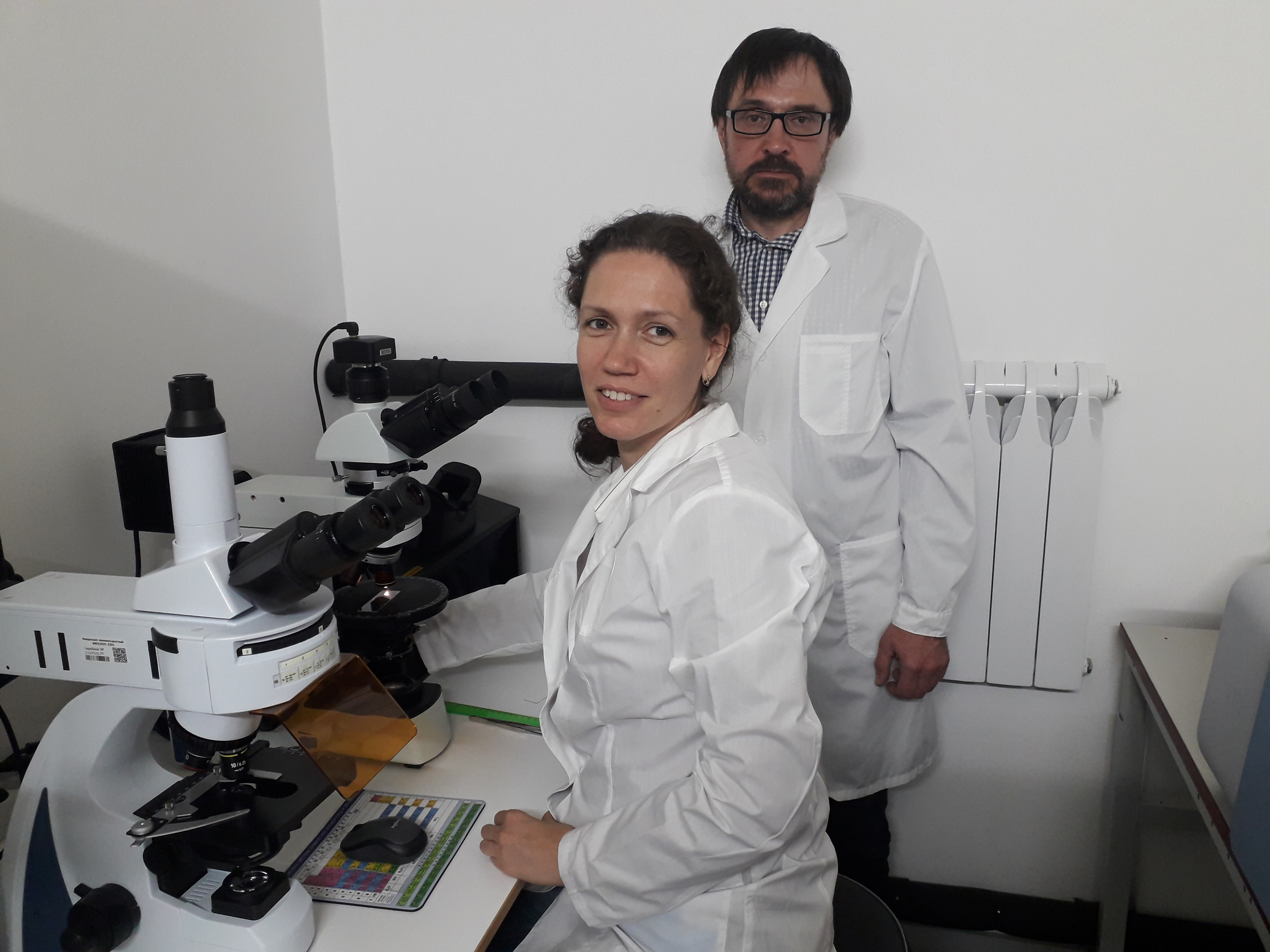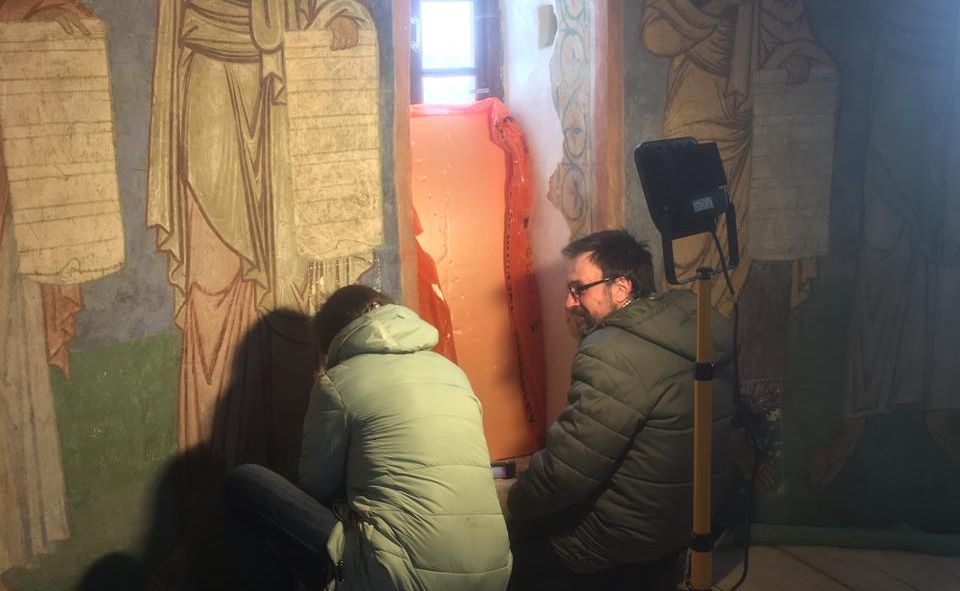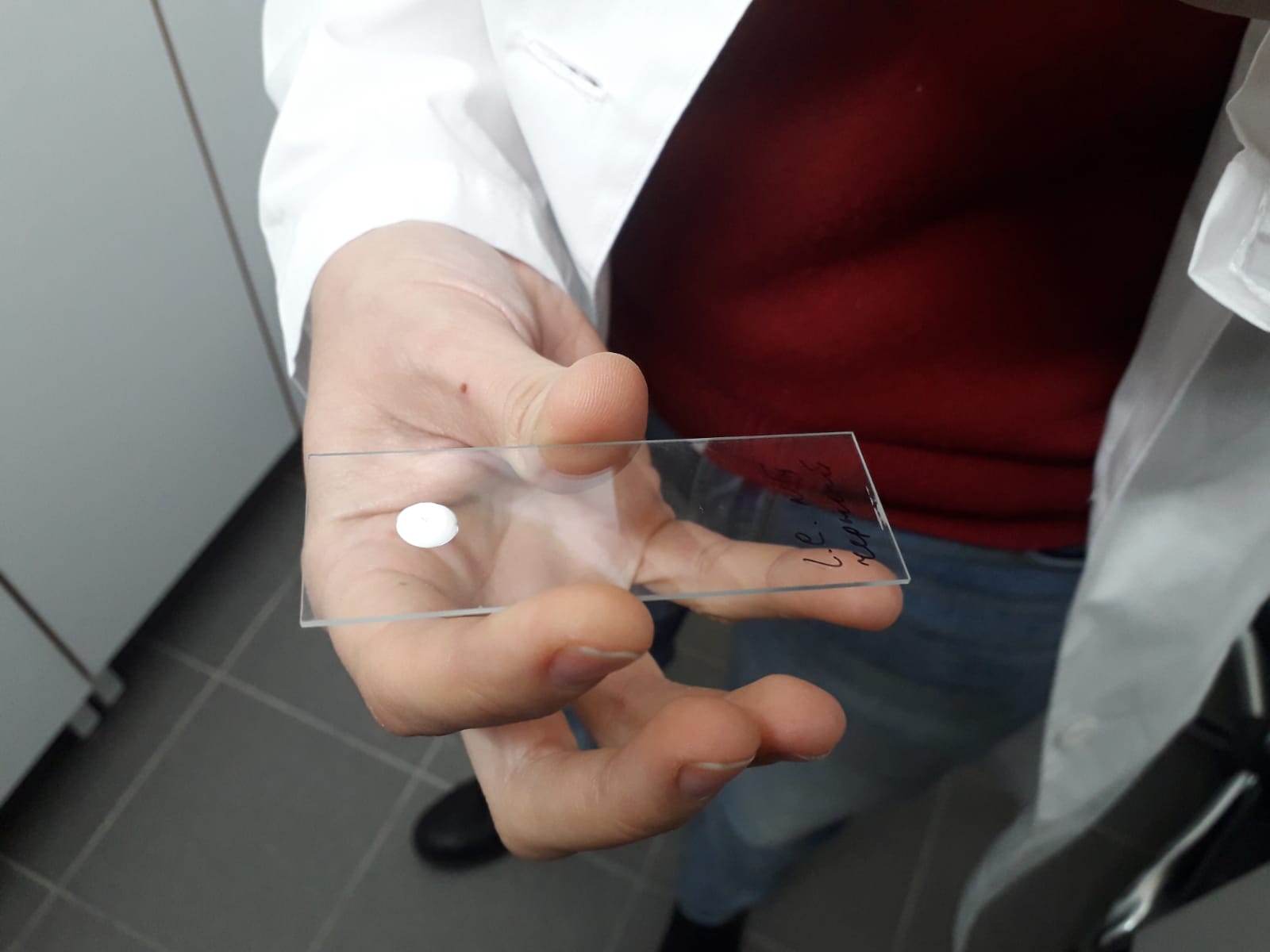Work of JINR scientists highly appreciated by art experts
News, 20 January 2022
On 18 January, the employees of the Group of Neutron Activation Analysis of the Laboratory of Neutron Physics JINR, Candidate of Chemical Sciences Olga Filippova and Candidate of Physics and Mathematics Andrey Dmitriev reported on a system of experimental and theoretical methods for studying physical and chemical properties and processes of medieval fresco painting at a meeting of the Sector of Old Russian Art of the State Institute for Art Studies of the Ministry of Culture of the Russian Federation (SIAS).
 Olga Filippova and Andrey Dmitriev are carrying out stratigraphic research of painting samples at the Laboratory
Olga Filippova and Andrey Dmitriev are carrying out stratigraphic research of painting samples at the Laboratory
The detailed report has become the result of a two-year work performed by the Group of Neutron Activation Analysis (GNAA) of FLNP JINR on the study of the medieval fresco painting of old Russian churches using physical and chemical methods. The very fact of presenting the report to world famous specialists, authors of the most significant for medieval art research monographs, proves the relevance of the work performed by the JINR scientists. Frescoes of the St. George Cathedral of the Yuriev Monastery (Veliky Novgorod, XII century), the Transfiguration Cathedral of the Mirozhsky Monastery (Pskov, XII century), and the Smolensk Cathedral of the Novodevichy Convent ( Moscow, XVI century) have become the research objects. The scientists studied ancient paintings both in situ using X-ray fluorescence analysis and at FLNP JINR. Researchers studied samples submitted to the Laboratory using methods of neutron activation analysis, prompt-gamma neutron activation analysis, electron microscopy, infrared and Raman spectroscopy, chemical microanalysis, thermal experiments.
The JINR scientists presented the elemental composition of pigments of old Russian frescoes in particular. The authors suggested which minerals and organic compounds were in the composition of pigments and plaster bases. These data will help renovators to restore the original appearance of ancient frescoes. It will also help art historians to draw conclusions about the peculiarities of the technique of pre-Mongolian wall paintings and sociocultural features of creating unique ensembles.
 Scientists are carrying out in situ studies of the elemental composition of pigments in the Transfiguration Cathedral of the Mirozhsky Monastery (Pskov)
Scientists are carrying out in situ studies of the elemental composition of pigments in the Transfiguration Cathedral of the Mirozhsky Monastery (Pskov)
Yellow and red ochres, white lead, green earth, lime, cinnabar, possibly malachite and azurite were found among the pigments in the studied monuments. The discovery of lazurite in blue fragments of St. George’s Cathedral in Novgorod was especially interesting. The use of such a rare and expensive pigment for the Middle Ages indicates the social significance of the painting customers.
The method of modelling the conditions of a medieval fire applied by the scientists opens up broad prospects. The study has shown how exactly the colours of ancient paint are reborn under high temperatures. Thus, yellow and green samples of frescoes acquire red shades when gradually heated from 100 to 1,100 °C. The scientists hope that this experiment will help to solve a perennial problem related to colour characteristics of such significant old Russian masterpieces as the painting of Theophanes the Greek.
 Sample of a produced microsection for stratigraphic studies
Sample of a produced microsection for stratigraphic studies
Stratigraphic studies of fragments provide a conclusion about the number and sequence of layers applied. They allow finding out which technique ancient masters used. Received data also help to understand specific features of the creative process, such as application of an ornament over the main shade, the use of preparatory drawing, correction of mistakes of a young artist by an experienced master. In the conclusion of the report, Andrey Dmitriev invited art historians to JINR to talk about noteworthy moments of their research activities and also to see physical facilities at which the scientists carried out the analysis: the IBR-2 Reactor and the IREN Facility.
Employees of the State Institute for Art Studies were keenly interested in the report by the JINR scientists. Prominent art experts highly appreciated the performed work. They highlighted that the research results of the JINR scientists provide the substantiation of a theoretical hypothesis using objective data. “Studying this side of old Russian monumental painting is very promising,” a chief researcher of the SIAS Sector of Old Russian Art, Doctor of Art History, Professor Engelina Sergeevna Smirnova noted.
The conducted research verifies the assumptions of art historians about the composition of ancient paint. Head of the SIAS Sector of Old Russian Art, Doctor of Art History, Professor Lev Isaakovich Lifshits expressed a desire to further develop methodological recommendations for conducting research on old Russian fresco painting by physical and chemical methods.“I am glad that the conclusions of art historians have found serious confirmation in this study. At the same time, a step that allows identifying ways to restore the original colour has been taken,” a leading researcher of the SIAS Sector of Old Russian Art, Doctor of Art History Tatiana Yurievna Tsarevskaya concluded. She added that according to the results of the research, the cooperation programme for 2021 was even exceeded, “Studying changes in the original colour of particular monuments was the aim for 2022. At that rate, we can achieve significant results. The material collection is underway, and there are already some results. This is great.”
Tatiana Yurievna presented a plan for further joint research to participants of the meeting. It covers the formation of a database of the elemental composition of pigments of old Russian paintings, determination of the degree of change in the original colour of frescoes, clarification of the attribution of some monuments. The joint plan will also include tasks of comparative analysis of monumental painting in Novgorod churches of XII century and a study of monuments of XIV century, during which a transformation of the technique of old Russian fresco painting took place.
A leading researcher of the SIAS Sector of Old Russian Art, Doctor of Historical Sciences Leonid Andreevich Belyaev said that until 2024, the jubilee publication about Smolensk Cathedral of the Novodevichy Convent will be prepared. It will be devoted to its architecture, painting, and archaeology. Leonid Andreevich proposed to include the results of the JINR scientists in this publication. Moreover, a senior researcher at SIAS Elina Nikolaevna Dobrynina raised a question about the possibility of studying old Russian paintings using physical and chemical methods.
At the end of the meeting, Andrey Dmitriev and Olga Filippova expressed gratitude to the art historians from SIAS for the high appreciation of their work and trust.